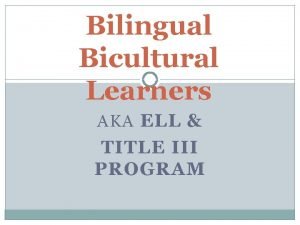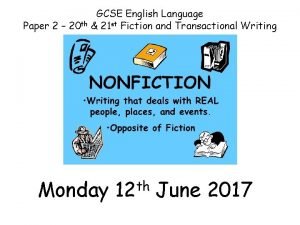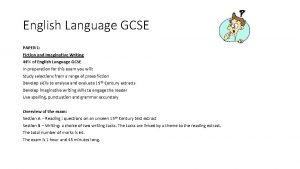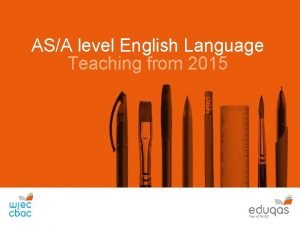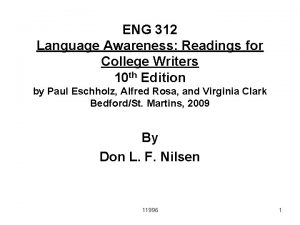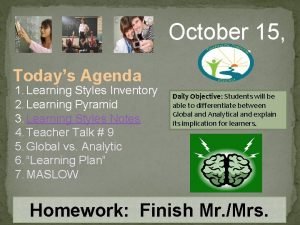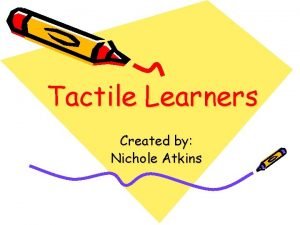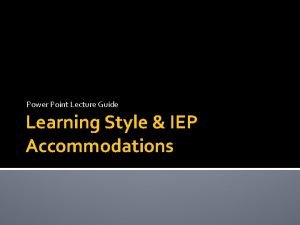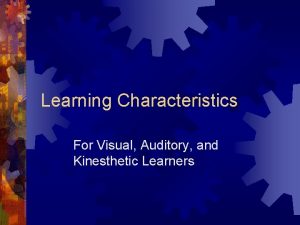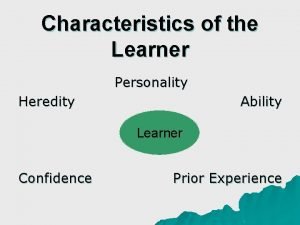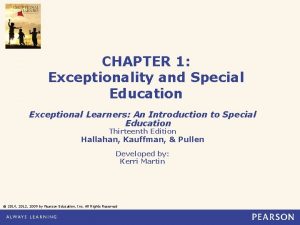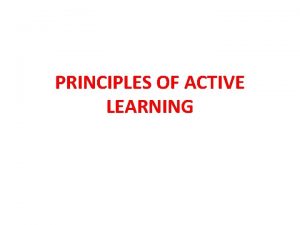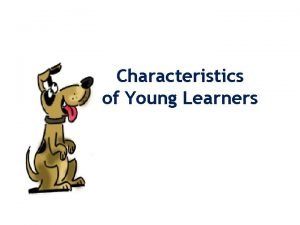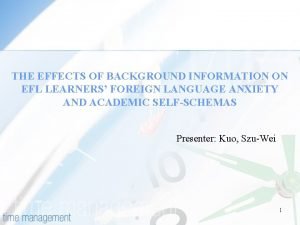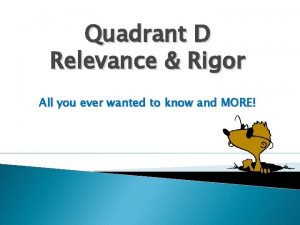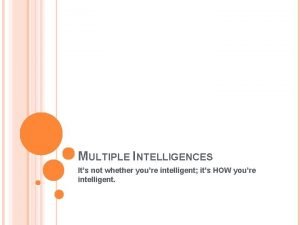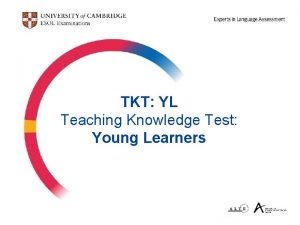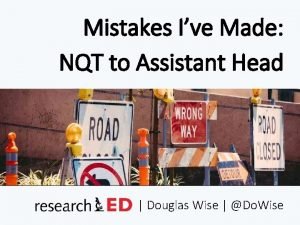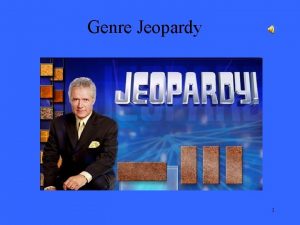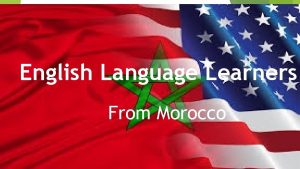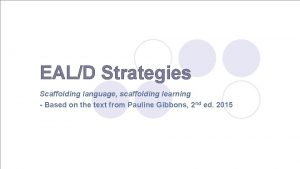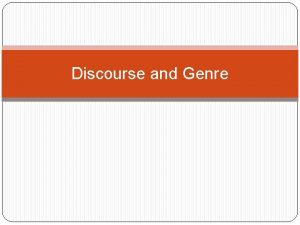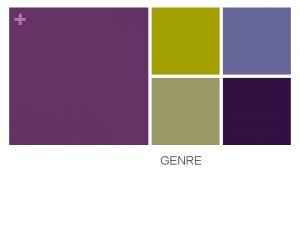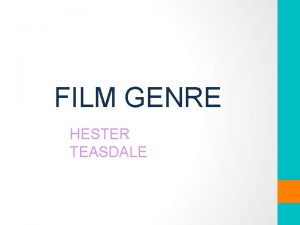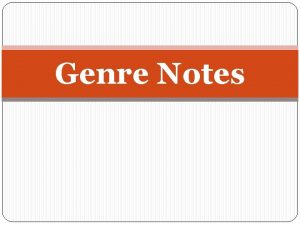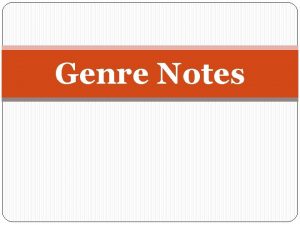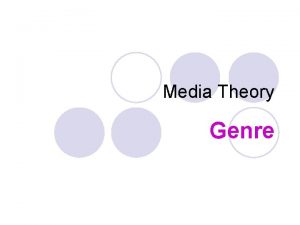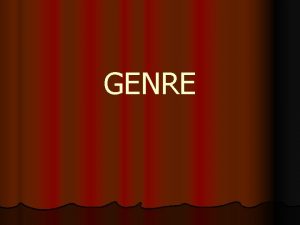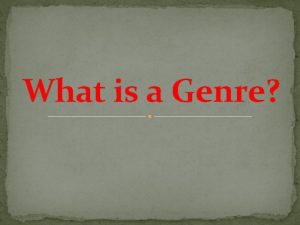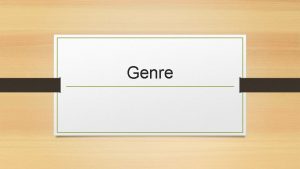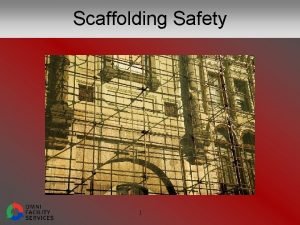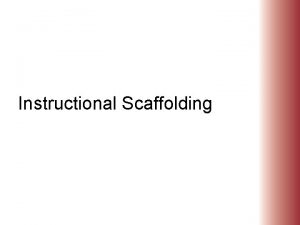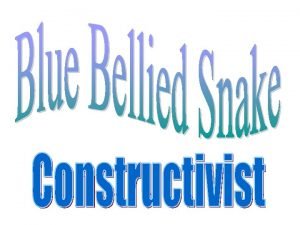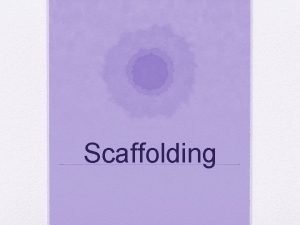Scaffolding Writing for English Language Learners Genre Awareness
































- Slides: 32

Scaffolding Writing for English Language Learners: Genre Awareness and Text Features Elizabeth Smith English Language Fellow

Agenda �Genre Theory: Writing for a Purpose �Overview of Genres �Text Features �Strategies for Teaching Specific Genre �Debrief

1 Once upon a time…

1 Once upon a time… Folk/fairy tale

2 Dear sir…

Dear sir… formal letter 2

3 6 eggs bread juice…

3 6 eggs bread juice… shopping list

4 “The next stop is…Managua. ”

4 “The next stop is…Managua. ” bus announcement (informative)

5 This process is called photosynthesis.

5 This process is called photosynthesis. science textbook – explanation

What are genres?

Language Genres… �Categories of texts § Determined by a set of parameters § Used for a variety of purposes § Used in a variety of contexts § Can be written or spoken § Can be formal or informal

Examples of Language Genres: Categories of Written Texts �Narrative: novels, short stories, biographies, autobiographies, historical accounts, plays �Expository: letters, newsletters, definitions, instructions, guidebooks, catalogs, newspaper articles, magazine articles, pamphlets, essays, reports �Persuasive: argumentative essays, discussion papers, advertisements, persuasive letters

Language Genres: Categories of Written Texts �Expressive: poems, songs, sayings, proverbs, mottos �Technical: research papers, lab reports, medical reports, accident reports, progress reports, directions (to a destination), manuals, evaluation forms, questionnaires, business letters, resumes, presentations, descriptions of features (products/designs/projects), instructions

Language Genre Parameters The parameters that determine language genres are: �Purpose �Audience �Context �Format

Purpose Why a speaker is speaking or a writer is writing – the reason for the text, related to the topic, function, & aim Examples of PURPOSE include: �To exchange information �To make arrangements �To negotiate a decision �To give instructions �To express feelings �To make a complaint �To express thanks

Audience �Who the text is aimed at – target person/group of people (the reader or listener) Examples of AUDIENCE include: • General public, spectators, audience (theater, movie, concert, sport, etc. ) • Students, colleagues, friends, family • Visitors to a website (“browsers” or “users”) • Participants in a workshop, presentation • Members of a sports team • Rhetorical audience, an anonymous listener or reader, or yourself

Context Where and when the written text will be read or the speaking is taking place – the time, place, and situation (the setting) �Examples of CONTEXT include: �Time period (present, past, or future) �A public place (street, square, park) �At the workplace (factory, office) �In the city, in a village, in the country �On TV, radio, a website, in the newspaper �In a meeting, workshop, or presentation �At an event (wedding, graduation, opening)

Format How it is delivered – what form it will be published or presented in Examples of FORMAT include: Spoken: �Direct/face-to-face (conversation, meeting, recital, loud speaker) �Broadcast live on TV or radio �Pre-recorded video (DVD, video files, podcasts)/audio (CD, audio files)

Format Written: �Handwritten (letter, memo, notes, essay, list) �Printed/“hard copy” (letter, book, magazine, newspaper, journal, document) �Digital/“soft copy” (CD-ROM/flash drive, website, computer files, online chats, scanned documents)

�So, what exactly do the parameters determine? �In other words, what are the characteristics of a genre?

Characteristics of a Genre The characteristics of a genre can be put into two groups: �Text structure �Text features Note: All texts, whether written or spoken, have text structure and language features. However, FORMAL TEXTS have CONVENTIONAL FORMS – with more established text structures and language features.

Text Structure Text organization and form: �Parts or sections of the text �Introduction, body, conclusion �Paragraphs & paragraph structure �Subheadings, subtitles, & summaries

Text Features: �Titles, subtitles, captions, pictures �Form: letter, poem, essay, letter �Language Use: (formal vs. informal �Tone: persuasive vs. informative

Genre Awareness & Text Study �Genre-based learning helps native and non-native learners of English improve as it focuses producing a whole text. �“Studies show that explicit genre-based instruction with the attendant metalanguage helps learners improve their writing. ” [1] �Genre awareness and text study gives both native and non-native users of English greater language independence.

Strategies for Teaching Genre 1) Explicit Teaching � of Genre Awareness “This is a nonfictional, informative text and I know this because of the research presented and the sources referred to by the author. 2) Effective Modeling � Show vs. Tell 3) Guided � through Samples Writing Deconstruct texts together and analyze text features 4) Group Curriculum Based on Genre Studies � Units organized into genres: Biographies/Narratives, Expository, Persuasive, etc.

Activity: Identifying Text Features Interview, Directions, Fable, Editorial Letter, Narrative, Persuasive Speech, Poem Genre: Purpose: Features:

Debrief �What are genres? �What are the four language parameters of teaching language genre? �How is teaching genre awareness explicitly helpful to English Language Learners?

Homework! �Read: “ 7 Steps to Teaching a Genre” and “Promoting Genre Awareness in the EFL Classroom” �Plan: Think strategically and plan how you can begin incorporating genre awareness into your lessons

Thank you! Next Session: Thursday, September 26 th at 2: 00 pm! Elizabeth Smith elfsmith@ccnn. org. ni Source: “Genre Awareness & Text Study in the ESL/EFL Curriculum” by Phillip Keane. Presented at UAE, 2011.
 Audioize
Audioize English language learners
English language learners Reading strategies for english language learners
Reading strategies for english language learners Equal protection for english language learners
Equal protection for english language learners Cvs privacy awareness and hipaa training answers
Cvs privacy awareness and hipaa training answers Teaching young learners english
Teaching young learners english Aqa eng lang paper 2
Aqa eng lang paper 2 Is english language paper 1 fiction or nonfiction
Is english language paper 1 fiction or nonfiction Levels of language knowledge
Levels of language knowledge Language awareness readings for college writers
Language awareness readings for college writers Global vs analytical learners
Global vs analytical learners What is grammar
What is grammar Facts about tactile learners
Facts about tactile learners A teacher should adopt “remedial teaching” for:
A teacher should adopt “remedial teaching” for: Global vs analytical learners
Global vs analytical learners Characteristics of kinesthetic learners
Characteristics of kinesthetic learners Eager learner examples
Eager learner examples Kinesthetic learners definition
Kinesthetic learners definition When is cognitivism beneficial for learners
When is cognitivism beneficial for learners Domain 3 diversity of learners examples
Domain 3 diversity of learners examples The teacher and the profession article iv
The teacher and the profession article iv Characteristic of learners
Characteristic of learners Exceptional learners: an introduction to special education
Exceptional learners: an introduction to special education Active learners definition
Active learners definition Young learners characteristics
Young learners characteristics Questioning strategies to engage all learners
Questioning strategies to engage all learners Background information for learners
Background information for learners Quadrant d
Quadrant d This institution is for gifted students in the philippines
This institution is for gifted students in the philippines Famous person with kinesthetic intelligence
Famous person with kinesthetic intelligence Learners will be able to
Learners will be able to Tkt young learners
Tkt young learners Graham nuttall the hidden lives of learners
Graham nuttall the hidden lives of learners

